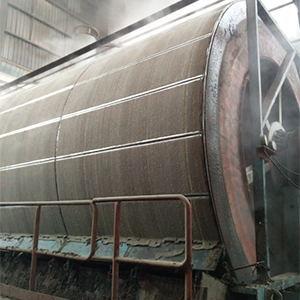Biogas Production From Press Mud
Press Mud: Brown Gold

Press Mud or Filter Cake is the solid waste generated during the clarification of cane juice before its concentration and sugar crystallization. It is a by-product of cane juice distillation that needs to be discarded. Usually found in solid cake form, this solid waste becomes a big headache for the factories to get rid of, sometimes by even paying for disposing it off. This headache is an ideal feedstock for Biogas generation, which can be used as Biofuel for the vehicles as well as electricity generation by feeding it in the boilers. Press mud not only generates biogas but also produces other major byproducts such as Carbon dioxide and organic manure. Considering the amount of additional revenue that a factory waste can generate, we can also call press mud a brown gold.
Process
During the juice clarification stage, sugar mills generate a substantial amount of press mud. The resulting press mud is highly organic in nature, with traces of sugar content. Press mud is an organic matter source that can be digested anaerobically and transformed into methane-rich biogas. It is also a good source of organic manure due to its high fiber and humus content. As a result, the solids separated from the post-anaerobic compost in Pressmud are a rich source of manure.
The Biogas thus produced can be used for various purposes such as vehicle fuel, cooking and electricity generation. The high organic matter content of Biogas is an advantage over other energy sources. If the Biogas can be used as a fuel for cogeneration, the biogas can reduce the cost of electricity generation by as much as 40%. This is due to the ability of biogas to reduce carbon dioxide emissions, which is one of the major CO2 emitters from the power generation sector.
| Typical Characteristics Of Indian Press Mud Cake (Sugarcane) | ||
| Compound | % | Components |
| Total solids | 26-30 | Simple sugar, Cellulose, Hemi cellulose, Protein, wax & Lignin |
| Total Volatile Solids w.r.t TS | 22-23 | |
| Ash | 6-7 | Minerals |
| Typical Output From Press Mud | |
| Biogas Yield (typical) | 100 - 110 Nm3/h |
| CH4 | 55 - 60% |
| CO2 | 45 - 40% |
Snapshot Of Biogas Generation From Press Mud
On an average, The quantity of Press Mud is roughly about 3.5 to 4 % of total sugarcane crushed. Let’s understand the potential of Press Mud
| Press Mud feed | 1000 kg |
| Solid manure | 250 kg (40% moisture) @ INR 2.5 - 3/kg* |
| CBG | 39 kg @ INR 46 - 52/kg |
| LCO2 | 58 kg @ INR 8 - 10/kg |
*If solid manure from the digester is converted to PROM it may sell at Rs. 6 - 8/kg.
Above figures may vary location wise.
Enhancing Biogas Production From Press Mud

To enhance the final output of biogas from Press Mud, substrate quality needs to be assessed. Biogas potential based on aggregate and unstable solids, macronutrients, minor components and dietary benefit of the press mud is to be undertaken. Studies have established that biogas yields are greatly influenced by the local soil structure, water quality, and the manures used in the growing of sugar.
A nutrient balance among the macronutrients and trace elements is essential to ensure that the optimal concentration of each macronutrients is maintained in the biogas. The concentration of macronutrients for biogas production is determined by the type of solids present in the mixture of press mud and manure.
Why Go For Biogas From Press Mud?
Biogas production from anaerobic processing has been by far the best way to produce biogas for several reasons: Firstly, it is the only process that converts Press mud to Biogas. Secondly, it is an extremely efficient process due to the high rate of biogas production, which is higher than in anaerobic digestion of manure, for instance. Finally, the biogas produced is an environmentally responsible fuel as it does not produce greenhouse gases.
The Government of India has introduced various incentives to encourage the use of the Biogas from Press Mud. The SATAT, Sustainable Alternatives Towards Affordable Transportation, in October 2018 to encourage biogas production for sale as automotive & industrial fuel. It was established as a joint venture between leading OMCs (HPCL, IOCL, BPCL & GAIL).
In India, the projected Compressed Biogas potential from diverse sources is around 62 MMT, with a capacity for bio-manure generation of 370 MMT. India aims to produce 15 MMT (million metric tonnes) of CBG from 5000 plants by 2023.
• Compressed Biogas (CBG) is being hailed as the perfect green fuel, and it is likely to overhaul the Indian fuel sector.
• The biogas contains around 55% to 60% methane, 40% to45% carbon dioxide, and trace levels of hydrogen sulphide.
• The biogas is cleaned to eliminate H2S, CO2, H2O, and compressed as compressed biogas (CBG) with a methane (CH4) content of more than 90%.
• Similar to CNG in terms of calorific value and other features.
• When used as a green renewable automobile fuel and transported to retail outlets by cylinder cascades or pipelines, it has the potential to replace CNG in automotive, industrial, and commercial applications.
With the unmatched capability of generating profit out of a waste, need of the hour ang government’s encouragement for adaption of a renewable energy; it is the right time to explore the possibilities and invest in the Press Mud based Biogas generation plant that can boost the sustainability of the Sugar factories to a whole new level.Let’s add a few images in articles… if you like the idea.